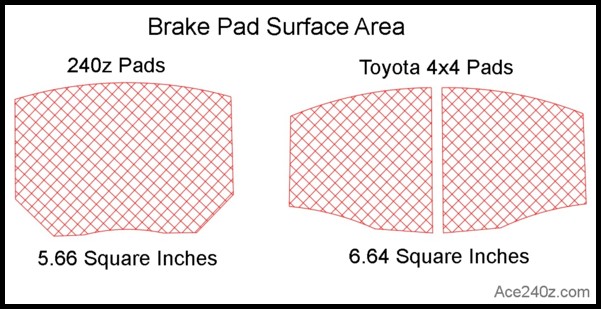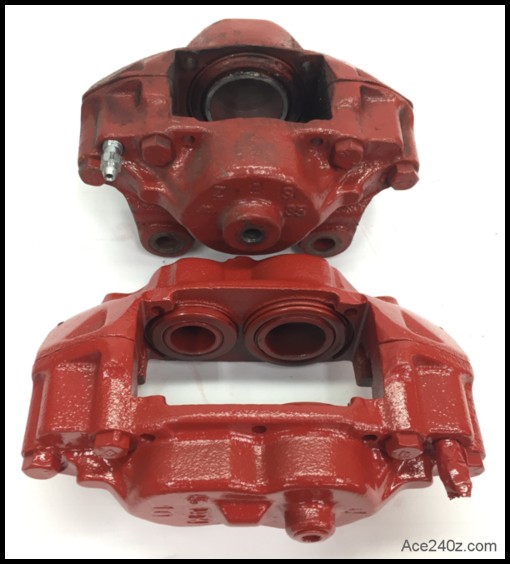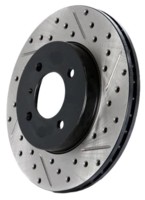
The Toyota 4x4 Brakes Upgrade Myth
This is a great way to make your brakes worse
Originally this page was going to be a guide to upgrading your stock caliper brake calipers to the Toyota 4x4 version. It's a popular conversion but depending on how you do it, the swap might not change your current braking ability and could possibly make it worse. I'm serious. When the 240z was unleashed in 1970, the front brakes were pretty good. They're twin-piston calipers squeezing a solid steel rotor via a vacuum-boosted master cylinder, but compared to modern brakes they need a slightly heavier foot to drag the car to a halt. For daily driving and an occasional track day, they're perfectly fine but I'd heard about the upgrade and decided to give it a try. The calipers from a '79-'84 Toyota 4x4 pickup bolt right in place. All you need to do is trim the backing plate and replace the hardlines. It's pretty cheap and fairly easy. A decent mechanic can do the entire thing in about two hours. I'm pretty capable, so I decided to go for it. I bought all of the parts and was ready to start but noticed a couple of odd things:
- The new brake pads didn't look much bigger than the stock ones.
- The stock pistons are larger than I'd expected.
The Pads
 I took photos of the brake pads and imported them into AutoCAD and traced the outlines to see how they compared. It was a little surprising.
The 240z pads have a combined surface area of 22.64 sq inches.
The Toyota 4x4 pads have a combined surface area of 26.56 sq inches.
That means the Toyota pads are only 17% larger.
Larger pads by themselves won't increase the braking ability. All they'll do is help dissipate the heat, which allows you to brake a tiny bit longer without the brakes fading.
I took photos of the brake pads and imported them into AutoCAD and traced the outlines to see how they compared. It was a little surprising.
The 240z pads have a combined surface area of 22.64 sq inches.
The Toyota 4x4 pads have a combined surface area of 26.56 sq inches.
That means the Toyota pads are only 17% larger.
Larger pads by themselves won't increase the braking ability. All they'll do is help dissipate the heat, which allows you to brake a tiny bit longer without the brakes fading.
The Calipers
 Here are the calipers next to each other and you can see the pistons.
The 240z calipers have two pistons. Both are 1.875" dia. The combined surface area (2 calipers with 2 pistons) is 11.04 sq inches.
The Toyota 4x4 calipers have four pistons. Two are 1.5" dia and two are 1.125" dia. The combined surface area (2 calipers with 4 pistons) is 11.04 sq inches.
In other words, both sets of calipers have the same surface area which means they exert the same amount of force, which means nothing has changed.
The only difference is the Toyota calipers weigh 3 pounds more.
Here are the calipers next to each other and you can see the pistons.
The 240z calipers have two pistons. Both are 1.875" dia. The combined surface area (2 calipers with 2 pistons) is 11.04 sq inches.
The Toyota 4x4 calipers have four pistons. Two are 1.5" dia and two are 1.125" dia. The combined surface area (2 calipers with 4 pistons) is 11.04 sq inches.
In other words, both sets of calipers have the same surface area which means they exert the same amount of force, which means nothing has changed.
The only difference is the Toyota calipers weigh 3 pounds more.
The Master Cylinder
 The 240z master cylinder is 7/8" diameter which is properly sized for the stock calipers, but the Toyota calipers, which are designed for a truck, need a larger amount of fluid. If you swap the calipers, the stock 240z brake pedal has to move further to pump the increased amount. It's roughly twice as much travel. It works fine, but feels odd getting so close to the floor.
A popular "cure" is a Wilwood 1" dia master cylinder. The mounting holes need to be slightly enlarged and new hard lines to the distribution block have to be made. With that swap, the pedal remains in the same place as before and with the same amount of travel.
But there's a hidden problem. As the diameter of a master cylinder increases, the amount of pressure decreases.
If you push the brake pedal as hard as possible, you can create about 100 lbs of force. With a 7/8" dia master cylinder, that results in 167 psi, but with a 1" dia master cylinder the pressure is only 127 psi. That's a 24% decrease in clamping pressure which means your brakes are now worse than stock.
To bring the pressure back up, you'll need to swap the booster to one from a 280z, which adds more time and money. I don't know how much it increases the pressure, but I know for certain it won't work on a '70 or '71 because the mounting pattern is different.
If you want to see the math for all of that, as well as how a master cylinder should be sized for different applications, here's a link to Joe's Racing Products which is a really great website that explains everything.
The 240z master cylinder is 7/8" diameter which is properly sized for the stock calipers, but the Toyota calipers, which are designed for a truck, need a larger amount of fluid. If you swap the calipers, the stock 240z brake pedal has to move further to pump the increased amount. It's roughly twice as much travel. It works fine, but feels odd getting so close to the floor.
A popular "cure" is a Wilwood 1" dia master cylinder. The mounting holes need to be slightly enlarged and new hard lines to the distribution block have to be made. With that swap, the pedal remains in the same place as before and with the same amount of travel.
But there's a hidden problem. As the diameter of a master cylinder increases, the amount of pressure decreases.
If you push the brake pedal as hard as possible, you can create about 100 lbs of force. With a 7/8" dia master cylinder, that results in 167 psi, but with a 1" dia master cylinder the pressure is only 127 psi. That's a 24% decrease in clamping pressure which means your brakes are now worse than stock.
To bring the pressure back up, you'll need to swap the booster to one from a 280z, which adds more time and money. I don't know how much it increases the pressure, but I know for certain it won't work on a '70 or '71 because the mounting pattern is different.
If you want to see the math for all of that, as well as how a master cylinder should be sized for different applications, here's a link to Joe's Racing Products which is a really great website that explains everything.
What All Of That Means
 A former roommate has a PhD in mechanical engineering, so I asked him a few questions about brakes and his answers weren't what I expected. He's the guy with the doctorate and I'm just a high school grad so I have to trust his knowlege.
Putting larger pads on the stock rotor won't make any difference because disc brakes work mainly by squeezing, not by friction. As shown above, the Toyota caliper pistons have the same surface area as the 240z calipers, so they can't clamp any harder.
Changing to the larger master cylinder decreases the pressure.
Here's what you've accomplished:
Your brakes are exactly the same, or worse, the calipers weigh more and your wallet weighs less.
I've talked with a lot of people who disagree with the above. They claim the swap has significantly improved their brakes but I think it's wishful thinking because the math is clear. They spent the time to make the swap so "obviously" the brakes work better.
A former roommate has a PhD in mechanical engineering, so I asked him a few questions about brakes and his answers weren't what I expected. He's the guy with the doctorate and I'm just a high school grad so I have to trust his knowlege.
Putting larger pads on the stock rotor won't make any difference because disc brakes work mainly by squeezing, not by friction. As shown above, the Toyota caliper pistons have the same surface area as the 240z calipers, so they can't clamp any harder.
Changing to the larger master cylinder decreases the pressure.
Here's what you've accomplished:
Your brakes are exactly the same, or worse, the calipers weigh more and your wallet weighs less.
I've talked with a lot of people who disagree with the above. They claim the swap has significantly improved their brakes but I think it's wishful thinking because the math is clear. They spent the time to make the swap so "obviously" the brakes work better.
Here's The Only Way The Upgrade Helps
 The Toyota 4x4 calipers are wider between the pads, which means you can use vented rotors from a 300zx (with a special shim). Both can be found in Z stores and on eBay but it increases the cost of the upgrade.
Your car still won't slow down any faster (same size pads, same amount of pressure), but the vented rotors will allow you to stop for a longer amount of time before the heat from the friction causes the brakes to fade.
That means nothing during daily driving. Have your brakes ever faded, even during a panic stop? If you go up into the hills and drive more aggressively, it'll take much longer before there's any fading, but once again, the brakes themselves don't work any better.
The biggest advantage is when you're racing, which is pretty much all acceleration and deceleration. You can brake very hard for longer periods but that's not something you'll be doing around town.
The Toyota 4x4 calipers are wider between the pads, which means you can use vented rotors from a 300zx (with a special shim). Both can be found in Z stores and on eBay but it increases the cost of the upgrade.
Your car still won't slow down any faster (same size pads, same amount of pressure), but the vented rotors will allow you to stop for a longer amount of time before the heat from the friction causes the brakes to fade.
That means nothing during daily driving. Have your brakes ever faded, even during a panic stop? If you go up into the hills and drive more aggressively, it'll take much longer before there's any fading, but once again, the brakes themselves don't work any better.
The biggest advantage is when you're racing, which is pretty much all acceleration and deceleration. You can brake very hard for longer periods but that's not something you'll be doing around town.
Rear Disc Brakes Conversion Your current drum brakes will already lock up during a panic stop so disc brakes in the rear won't make any difference aside from being heavier. Rear drum brakes are still used for the majority of cars, vans, minivans and pickups, so ask yourself why you need them for your Z.
Skeptical? I know some of you won't believe me, or the physics or the math, so send proof that your upgraded brakes work better for street use and I'll change this page, but it has to be real proof, not an opinion.